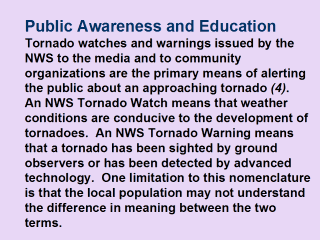 |
For example, after
the North/South Carolina tornado outbreak of 1986, a field survey of people
in the path of the tornadoes revealed that only 40% of them understood the
difference between a "watch" and "warning" (9). Community programs
such as maintaining a volunteer system of weather spotters may increase
rates of local tornado detection and improve warning dissemination. Because
of the strong association between the strength of tornadoes and their
potential to cause death or serious injury, tornado-related disaster
preparedness should concentrate on those parts of the country that have high
numbers of violent tornadoes (Fujita classes F4 and F5). Another important
component of disaster preparedness is to educate the public to seek
appropriate shelter, particularly in public buildings such as schools.
Improved hazardous weather awareness can also be promoted by encouraging
households located in tornado-prone parts of the country to have National
Oceanic and Atmospheric Administration (NOAA) "Weather Radios," which
provide 24-hour information to the public concerning adverse weather
conditions. |
